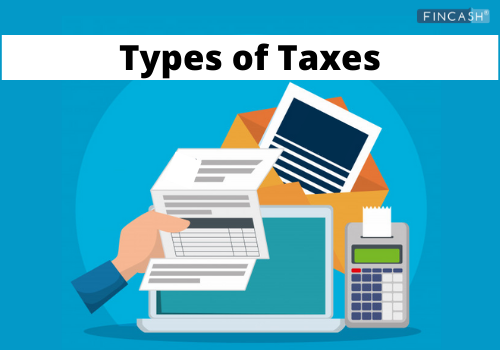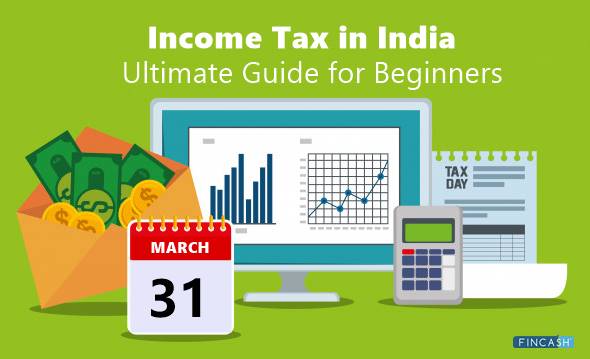
Table of Contents
Different Types of Taxes in India
Taxes are an essential part of the country’s Economic Growth. The taxes that we pay is utilised to improve various sectors of the country. As per the Indian Constitution, the Government has the authority to collect taxes and the taxes we pay are supported by the laws passed by either parliament or the State Legislature.

Let’s take a look at the different types of taxes in India.
Types of Taxes in India
India has two types of taxes - direct tax and indirect tax. The difference between both the taxes lies in their implementation.
1. Direct Tax
Direct taxes are a blend of several taxes, which we directly pay to the Government. These taxes are imposed on an individual and therefore it cannot be transferred to another person. The Central Board of Direct Taxes (CBDT) under the Department of Revenue is responsible for the governance of this tax.
There are various types of Direct Tax mentioned below:
a. Income Tax
income tax came into the picture with the Income Tax Act 1961. All the rules and regulations of the income tax are set by this act. Income tax is applicable on any income you earn from profits, property, salary, investments or business. The Income Tax Act 1961 has provisions that enable tax benefits for taxpayers through fixed deposits and Life Insurance premium.
b. Gift Tax
Originally, Gift Tax was introduced in 1958 and reintroduced in 2004. According to this act, the present/gift you receive exceeds in value of Rs 5 lakh will levy 30% of the tax. The tax excluded gifts from the spouse, family, parents and blood relatives.
c. Wealth Tax
Wealth tax is applicable not only on an individual, but also on hindu undivided family (HUF) and business. For example, if an individual wealth is more than Rs. 1 crore then you have to pay a 12 % surcharge. Companies whose turnover exceed 10 crores are liable to pay the wealth tax.
d. Capital Gains
Capital gains are a type of income tax imposed on the gains you make after the sale of a property. There are two types of Gains tax- long term Capital Gain and short term capital gains tax.
e. Long-term Capital Gains
Long term capital gains are imposed when you earn profit from selling something you’ve owned for a year or more. The Tax Rate for long- term capital gains rate is 0%, 15% and 20% depending on the Taxable Income.
f. Short term Capital Gains
A short term capital gain is calculated from a sale, transfer or disposition of personal or investment property. Short term capital occurs when the investment is sold that’ been held for a year or less such as stock.
Talk to our investment specialist
2. Goods and Service Tax
Goods and Service Tax was introduced in 2017. GST is applied at every stage of the supply chain wherever consumption takes place.
As per the new tax system, there are four types of GST:
- Integrated Goods and Service Tax (IGST)
- State Goods and Service Tax (SGST)
- Central Goods and Service Tax (CGST)
- Union Territory Goods and Service Tax (UTGST)
a. Integrated Goods and Service Tax (IGST)
The integrated goods and service tax is applied when the goods from one state is supplied to another state. This tax is governed by the IGST Act and under this act, the body is responsible for collecting the IGST. Later, the amount collected will be divided among the respective states by the Central Government. For instance, if a trader from Maharashtra sold his goods to a customer in Karnataka worth Rs. 6000 then IGST is charged at 18%. The trader will pay the final amount adding IGST is Rs. 6900, then Rs. 900 will go to the Central Government.
b. State Goods and Service Tax (SGST)
The State Goods and Service Tax is imposed when there is a supply of goods within a state. If the trader sold goods within the state, then he has to pay GST and SGST. For example- a trader in Maharashtra has sold the goods to a customer in Maharashtra, then he will be liable to pay SGST. If the GST rate is 18%, then the amount will be divided equally 9% CGST and 9% SGST. If the goods sold amount is Rs. 7000, then the trader has to pay Rs. 7900 from that - Rs. 450 will go to the State Government and Rs. 450 go to the Central Government.
c. Central Goods and Servies Tax (CGST)
The Central Goods and Service Tax is applied to the goods supplied within a state (intrastate) just like State Goods and Service Tax. For example- If the trader has sold the goods for Rs. 7000, then the GST is applicable will be partly CGST and partly SGST.
d. Union Territory Goods and Services Tax (UTGST)
The Union Territory Goods and Service Tax is equivalent to State Goods and Service Tax. It is levied on the supply of goods and services in the Union Territories in Andaman and Nicobar Islands, Chandigarh, Daman Diu, Dadra Nagar Haveli and Lakshadweep. This Act is governed by UTGST Act and the revenue is collected by the Union Territory Government.
3. Securities Transactions Tax
Share trading on the stock Market comes under the Securities Transaction Tax. For each share purchase or sale, you have to pay securities transaction tax.
4. Corporate Tax
Corporate tax is levied on the earning of business. Any Indian firm whose turnover is less than Rs. 1 crore is not subjected to this tax. There is a different tax structure for international firms and domestic firms.
Indirect Taxes
Indirect tax is not levied on individuals, but on goods and services. This tax is paid to the government by the intermediary then the amount adds to the value of goods and services.
Here are various Indirect taxes:
1. Sales Tax
Any product sold by a company is subject to Sales Tax. The product can be either domestically sold or imported to the outside country. Sales tax varies from state to state and the Central Government levies the sales tax. For some states, sales tax is one of the largest revenue sources.
2. Service Tax
Service tax is applicable to services provided by the company. This tax is charged on a monthly Basis and quarterly basis. It is paid when their customers clear their bills.
3. Value Added Tax (VAT)
Value added tax is imposed on products other than commodities such as food and essential drugs. It is placed at stages in the supply chain where value is added to the product.
4. Customs Duty
If you buy a product from a different country and Import it to India then you are liable to pay tax on that product it is called custom duty.
5. Toll Tax
Toll tax is levied either by the state or central government for roads and bridges. The major purpose of the toll tax is to maintain road construction and maintenance activities.
Conclusion
Both direct and indirect taxes are necessary for the economic growth of the country. Overall, a balanced mix of direct and indirect taxes can help to promote economic growth by providing the necessary funding for public services and infrastructure, while also encouraging responsible consumption and reducing income inequality.
All efforts have been made to ensure the information provided here is accurate. However, no guarantees are made regarding correctness of data. Please verify with scheme information document before making any investment.










